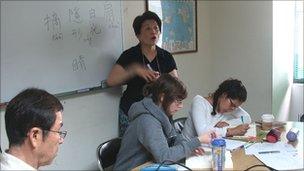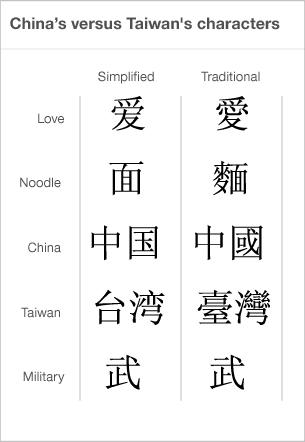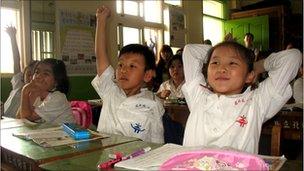China and Taiwan 'first joint dictionary'
- Published

Different forms of the Chinese language have developed in mainland China and Taiwan
A Taiwanese visitor to mainland China was shocked to see sliced "tu dou" on a menu. The word means peanut in Taiwan - but potato in mainland China.
A Taiwanese professor ordering coffee at a Beijing cafe was asked if he wanted a "coffee companion" - China's way of saying cream.
The stunned academic thought they wanted him to hire a hostess to keep him company. He told the waitress: "I didn't bring enough money."
Taiwan and China may share the same linguistic heritage - like Britain and the United States - but more than six decades of separation and political tensions have led to the Chinese language evolving in very different ways on each side; sometimes causing confusion, frustration or embarrassment.
Relations have been improving since 2008 and in the past year, the two former foes have been working on a first-ever joint dictionary that will encompass their different ways of writing and speaking Chinese.
The dictionary, named the Great Chinese Dictionary, will be free and put online.
A preliminary version containing more than 28,000 commonly used words and phrases will be unveiled by the end of this year, while a more comprehensive version will be available by 2015.
The project could help tens of million of non-native speakers studying Chinese worldwide. China's rise has made Mandarin Chinese a top choice for foreign language study.
But for Taiwan and China, the dictionary is aimed at bridging the language gap that has risen due to the two sides being ruled separately since the end of the Chinese civil war in 1949, and even as far back as 1895 when Japan colonised the island.
Language gap
One of the biggest differences is that China, starting in the 1950s, has required its people to use simplified Chinese characters to raise literacy. Taiwan continues to use traditional characters, which have more strokes, insisting they best represent the culture behind the language.

When it comes to speaking, while both sides use Mandarin Chinese as the official dialect, they say even simple words like rice, hot water, and panda differently - "mi fan," "bai kai shui," and "xiong mao" in China, versus "bai fan," "re shui" and "mao xiong" in Taiwan.
These differences might seem slight, but some are not. In China, you refer to your spouse as your "ai ren", but that means your lover in Taiwan.
Some words have been created on one side but not the other because of the influence of local dialects and each side's unique history.
For example - "dong xuan" means frozen garlic in China, but in Taiwan it's a slang derived from the widely spoken Minan dialect and means winning an election.
And the word for boxed lunch is "bian dang" in Taiwan, borrowed from the Japanese word "bento" during Japan's colonial rule, but in China it's "he fan" - literally box rice.
There are also variations in tones. And each side uses different characters to translate new scientific, medical and English terms, as well as names of important foreign places and people.
Such differences can sometimes cause confusion even at a high level.
On a groundbreaking visit to China in 2005, Taiwan's current ruling party Kuomintang's then-chairman Lien Chan used the phrase "yuan jing", meaning a positive goal for the future, to express his hopes for good bilateral ties.
Chinese journalists had no idea what he meant because they had never heard of the phrase.
Character debate
As interaction between China and Taiwan increases, people wonder which side will win out on the language front.
Will Taiwan move towards its giant neighbour's way of writing and speaking, or will the small island, which prides itself on being the repository of traditional Chinese culture, have more influence over China?
In terms of numbers, China has a clear upper hand. Besides its population of 1.3 billion, an estimated 40 million non-Chinese nationals are learning simplified characters, with more than 200,000 studying in China.
In contrast, only around 30 million people use traditional characters daily - mostly in Taiwan, Hong Kong and Macau - that's only about 2% of Chinese speakers. And only about 12,500 foreigners come to Taiwan to study traditional Chinese each year.
To counter this trend, Taiwan has stepped up scholarships and marketing. It plans to open its version of the British Council beginning this year. And its top school for teaching foreigners Chinese - the National Taiwan Normal University (NTNU) - recently launched a free internet-based Chinese learning programme to encourage more people to learn traditional Chinese.
There is also growing interest among Chinese people in traditional Chinese culture, including the language.
Increasingly, they wonder for example how the simplified word for love can be missing the character for heart, and the word for noodle the character for wheat. Both are included in the traditional versions.
Many Chinese also prefer to use traditional characters to print their names on business cards.
Not only do the characters look better - they are like pictures that provide clues to the philosophy and evolution of Chinese words. For example, "armed forces" is made up of the words "stop" and "fighting" - as militaries were seen as tools to stop wars.
There is even growing resistance against simplification among Chinese linguists tasked with simplifying more characters, said Constance Lin, a Mandarin teacher at NTNU.
"They spend a lot of money and time trying to simplify more characters each year, but the scholars want to stop the simplification; they are urging the government to slowly return to standard characters," said Lin.
"You won't see this reported by China's media, but that's what the scholars are telling us."
Mainland students are beginning to come to Taiwan to learn traditional Chinese. And other than Singapore and Malaysia, traditional Chinese is more commonly used in overseas Chinese communities.
'Confusion'
At the same time, however, simplified characters are increasingly appearing in Taiwan. Many Taiwanese use them when handwriting. Even the first character for the word Taiwan is often written in the easier-to-write way.
To cater to the more than 1.5 million Chinese tourists now visiting Taiwan each year, many Taiwanese hotels, shops and even government agencies put out brochures, signs and menus in simplified Chinese.

Will pupils in the future be typing rather than handwriting Chinese characters?
It remains to be seen whether the dictionary, which will be presented in both traditional and simplified Chinese, will have an impact on the two sides' language rift.
For now, all agreements signed between them - including a landmark free trade agreement - are printed in simplified Chinese for China, and traditional Chinese for Taiwan.
Taiwan's former premier Liu Chao-shiuan, who's heading the dictionary project, says the goal is not to convert one side to the other's way of writing or speaking, but to create a database of words and let the users decide "on both sides of the Taiwan Strait and for all the people who want to learn Chinese".
Ultimately, technology and need may be the decisive factors in the simplified versus traditional debate. Students in China and Taiwan are increasingly typing rather than handwriting. Even students at the best universities sometimes can't remember how to write certain characters.
At a Taipei primary school, a teacher recently gave a lesson on how Chinese words originated from drawings of what they represented.
But despite the students' excitement at guessing what the words were based on their pictures, at the end of the lesson, several students bemoaned the difficulties of writing Chinese.
"I don't really like to write Chinese characters; it's very tiring," said eight-year-old Lee Mi. In a few years, she will be handing in her homework typed.
But technology may also help spread the use of traditional Chinese characters, said Tsao Feng-fu, a distinguished linguistics professor.
"Complex characters will still retain their usage and advantage because in the future we'll need to write less, so simplified characters will not be as important," Tsao said.
A lot of material will be in digital form and traditional Chinese can be typed as easily as simplified Chinese. That means mainland Chinese people can read traditional characters and still handwrite using simplified characters, Tsao said.
That's what President Ma says he is hoping for - the joint dictionary was his idea.
Last year, he also advocated the two sides reach an agreement on the teaching of traditional and simplified characters in schools.
Although that sparked accusations from the opposition and Ma's own party that he was trying to spread simplified characters in Taiwan, he said he was actually hoping to influence Chinese people to learn traditional characters so that traditional Chinese will flourish again in China.
- Published14 April 2011
- Published6 October 2010
- Published21 December 2010